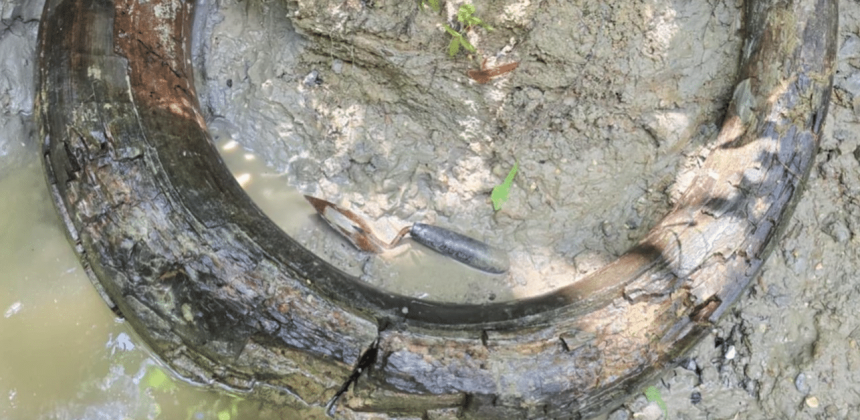A massive prehistoric discovery was made in central Mississippi with a seven-foot-long ice-age elephant tusk being found.
Earlier in August, geological survey scientists with the Mississippi Department of Environmental Quality (MDEQ) were notified by avid artifact and fossil collector Eddie Templeton of the giant finding. Templeton was exploring rural Madison County when he stumbled upon the tusk in a steep embankment.

Knowing that leaving the fossil exposed to the current Mississippi heat could dry the tusk out and ultimately destroy it, he acted quickly and called experts to the scene. When paleontological scientists arrived at the fossil site, they found the fossil tusk in quality condition as it was only partially exposed just above the water under a bluff. Based on the strong curvature of the massive tusk, it was suspected that they had encountered a Columbian mammoth and not that of the more common mastodon. This would be the first of its kind for the area.
Mississippi was home to three Proboscideans during the last ice age: the mastodon, gomphothere, and the Columbian mammoth. All three possessed ivory tusks. Mastodons are by far the most common Proboscidean finds in Mississippi as they were browsers, like modern deer, and inhabited a variety of different environments. Mammoths, which were related to modern elephants, are far less common finds in Mississippi as they were open grassland grazers and would have been at home in only a select few environments, particularly the prairie regions of Mississippi. Gomphothere are more closely related to mastodon than to mammoths, but very little is known about their ice-age presence here in the Magnolia State as they are only known from a few isolated teeth found along the Mississippi River.
After carefully removing all of the substances covering the tusk to unveil the fossil in its entirety, it was discovered that the tusk had been deposited entirely intact — meaning it was one whole structure, instead of the more common makeup of fragments that are usually pieced together.
Preservation methods then took place at the scene to have the fossil ready for transportation. The tusk was then delivered to the Mississippi Museum of Natural Science for further curation and careful study.
Once at the laboratory, the fossil tusk was confirmed by the Mississippi Museum of Natural Science paleontologist as indeed belonging to a mammoth. According to officials, Templeton’s discovery offers a rare window into the Columbian mammoths that once roamed Madison County along the Jackson Prairie of central Mississippi.
Columbian mammoths were much larger than the infamous woolly mammoth that roamed the colder, more northern regions of North America. They grew up to 15 feet at the shoulder and could weigh over 10 tons. These colossal mammals played an important role in maintaining the rich fertile prairie ecosystem, much as their modern elephant relatives do in other parts of the world today.
MDEQ confirms that the ice-age prairie ecosystem of what is now Madison County was also home to herds of now-extinct horses and giant bison, along with giant ground sloths, giant tortoises, and tapirs. It was also home to a number of ice age predators such as dire wolves, saber-toothed cats, American lions, and even the earliest human inhabitants of our region.
More information can be found here.







